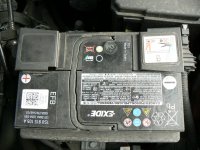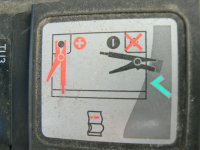I nearly posted this in the "Tech" section but then decided to put it here because it's not a Fiat only subject and also I think most of us keep a regular eye on this section so I might get more people reading it.
So, Electronic Battery Sensor? What is he talking about? Well, it's a wee gizmo which started to put in an appearance a few years ago and is now quite common on new cars. It's attached, usually, to the negative battery terminal and has, typically two wires (on the ones I've seen anyway) which disappear into the wiring loom. As far as I know the larger wire goes to a body earth and the thinner goes to an ECU which controls the "smart" alternator (maybe does other stuff too?) We have 2 cars in the "family fleet" which now have this sensor and as one of them is my Ibiza I want to know about it. So I've been asking questions and researching "stuff".
My main interest is in how it affects the way I deal with battery maintenance issues so things like connecting a charger, Jump starting, disconnecting the battery and replacing it if it fails and I need a new one.
This seems to be the one fitted on my Ibiza - just so you have some idea what I'm talking about:
https://www.bosch-mobility-solution...s/body-electronics/electronic-battery-sensor/
First thing to know is YOU CAN DESTROY IT IF YOU JUMP START IN THE "NORMAL" WAY. ie by connecting your jump leads directly to the vehicle battery terminals. I've long connected pos to pos then pos on donor battery/vehicle to block on "flat" vehicle to avoid any possibility of a spark igniting battery gasses These sensors monitor both voltage and CURRENT via a shunt. If you connect the leads directly to the battery the sensor is now not "seeing" the connected battery in the same way. I don't understand it all but I suspect you might get a reverse flow through the sensor? Result seems to be - POP! expensive sensor then needed! I've now seen several pieces of advice that if you must jump start then go pos on doner to pos on the "flat" vehicle then take your black lead connections to engine block on both vehicles. That way the sensors will be in circuit on both vehicles. If jumping with a jump pack or slave battery (as I do) then go pos to pos and neg to the flat car's engine block.
Battery charging is actually what's really motivating me looking into this as I have a smart charger which is supposed to allow charging without disconnecting the battery terminals without any risk of damage to electronics and I want to use it on the Ibiza. I don't want to disconnect the battery because all manor of "strange" things often follow doing that on modern cars. I tried the main dealer who, predictably, said don't jump start and don't connect a charger, end of! So I've held off but then asked on the Seat Cupra forum where I lurk around and was told connect to pos and the big earth bolt on the N/S inner wing. That seemed sensible to me as it follows the rational behind the jump starting instructions. Then, just today, I found a PDF for the Ateca Manual and, lo and behold, there's actually an instruction for battery charging which mirrors the advice given me on the forum.
I was thinking about the jump starting advice and actually I can't see any reason why not to just connect the black jump lead clamps block to block on any vehicle. Of course that is making the chassis earth cables on both vehicles then part of the circuit but as long as they are in good condition and their connections in good order that should make no difference? Think I'm probably just going to do this from now on.
Of course all the other standard advice appertains about making and breaking connections and especially, in my opinion, not to disconnect until the voltages of both flat and slave battery have stabilized. Ie let the cars run for a few minutes (maybe 5 to 10) before disconnecting any jump leads. Doing this minimizes the chance of sparks and surges.
So what have I learned so far (self test my memory)
1) when jump starting go pos to pos - as has always been done - but then black lead goes engine block to engine block. I have read that there might, very occasionally, be a sensor on the pos battery terminal, who knows what you do then?
2) when charging connect charger pos to battery terminal and charger neg to body earth. (almost certainly advisable to use a "smart" charger (I have a Ctek)
3) disconnect battery terminals at your peril as it may take a dealer level diagnostic tool to reprogram the ECU when you reconnect? Actually I don't like disconnecting batteries on modern vehicles anyway as I've found lots of "weird" stuff can happen - for instance my boy's Astra's front electric windows have to be "taught" how to wind up and down again! So I use a "memory saver" but I don't think it will save me with these newer systems?
I'd love for anyone who really understands what's going on with any of this to comment further. Oh, by the way, found this which seems to explain some of it in fairly simple language:
https://www.samarins.com/glossary/battery-sensor.html
Stay safe folks
Jock
PS. All the above is only as I understand it to be. If you go out and connect up your jump leads/battery charger and it all goes ***s up then you'll know I don't know what I'm talking about! In other words you try any of this at your own risk
So, Electronic Battery Sensor? What is he talking about? Well, it's a wee gizmo which started to put in an appearance a few years ago and is now quite common on new cars. It's attached, usually, to the negative battery terminal and has, typically two wires (on the ones I've seen anyway) which disappear into the wiring loom. As far as I know the larger wire goes to a body earth and the thinner goes to an ECU which controls the "smart" alternator (maybe does other stuff too?) We have 2 cars in the "family fleet" which now have this sensor and as one of them is my Ibiza I want to know about it. So I've been asking questions and researching "stuff".
My main interest is in how it affects the way I deal with battery maintenance issues so things like connecting a charger, Jump starting, disconnecting the battery and replacing it if it fails and I need a new one.
This seems to be the one fitted on my Ibiza - just so you have some idea what I'm talking about:
https://www.bosch-mobility-solution...s/body-electronics/electronic-battery-sensor/
First thing to know is YOU CAN DESTROY IT IF YOU JUMP START IN THE "NORMAL" WAY. ie by connecting your jump leads directly to the vehicle battery terminals. I've long connected pos to pos then pos on donor battery/vehicle to block on "flat" vehicle to avoid any possibility of a spark igniting battery gasses These sensors monitor both voltage and CURRENT via a shunt. If you connect the leads directly to the battery the sensor is now not "seeing" the connected battery in the same way. I don't understand it all but I suspect you might get a reverse flow through the sensor? Result seems to be - POP! expensive sensor then needed! I've now seen several pieces of advice that if you must jump start then go pos on doner to pos on the "flat" vehicle then take your black lead connections to engine block on both vehicles. That way the sensors will be in circuit on both vehicles. If jumping with a jump pack or slave battery (as I do) then go pos to pos and neg to the flat car's engine block.
Battery charging is actually what's really motivating me looking into this as I have a smart charger which is supposed to allow charging without disconnecting the battery terminals without any risk of damage to electronics and I want to use it on the Ibiza. I don't want to disconnect the battery because all manor of "strange" things often follow doing that on modern cars. I tried the main dealer who, predictably, said don't jump start and don't connect a charger, end of! So I've held off but then asked on the Seat Cupra forum where I lurk around and was told connect to pos and the big earth bolt on the N/S inner wing. That seemed sensible to me as it follows the rational behind the jump starting instructions. Then, just today, I found a PDF for the Ateca Manual and, lo and behold, there's actually an instruction for battery charging which mirrors the advice given me on the forum.
I was thinking about the jump starting advice and actually I can't see any reason why not to just connect the black jump lead clamps block to block on any vehicle. Of course that is making the chassis earth cables on both vehicles then part of the circuit but as long as they are in good condition and their connections in good order that should make no difference? Think I'm probably just going to do this from now on.
Of course all the other standard advice appertains about making and breaking connections and especially, in my opinion, not to disconnect until the voltages of both flat and slave battery have stabilized. Ie let the cars run for a few minutes (maybe 5 to 10) before disconnecting any jump leads. Doing this minimizes the chance of sparks and surges.
So what have I learned so far (self test my memory)
1) when jump starting go pos to pos - as has always been done - but then black lead goes engine block to engine block. I have read that there might, very occasionally, be a sensor on the pos battery terminal, who knows what you do then?
2) when charging connect charger pos to battery terminal and charger neg to body earth. (almost certainly advisable to use a "smart" charger (I have a Ctek)
3) disconnect battery terminals at your peril as it may take a dealer level diagnostic tool to reprogram the ECU when you reconnect? Actually I don't like disconnecting batteries on modern vehicles anyway as I've found lots of "weird" stuff can happen - for instance my boy's Astra's front electric windows have to be "taught" how to wind up and down again! So I use a "memory saver" but I don't think it will save me with these newer systems?
I'd love for anyone who really understands what's going on with any of this to comment further. Oh, by the way, found this which seems to explain some of it in fairly simple language:
https://www.samarins.com/glossary/battery-sensor.html
Stay safe folks
Jock
PS. All the above is only as I understand it to be. If you go out and connect up your jump leads/battery charger and it all goes ***s up then you'll know I don't know what I'm talking about! In other words you try any of this at your own risk
Last edited:



